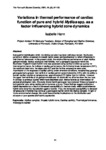Variations in thermal performance of cardiac function of pure and hybrid Mytilus spp. as a factor influencing hybrid zone dynamics
| dc.contributor.author | Hann, I. | |
| dc.date.accessioned | 2021-12-24T16:58:16Z | |
| dc.date.available | 2021-12-24T16:58:16Z | |
| dc.date.issued | 2021 | |
| dc.identifier.citation |
Hann, I. (2021) 'Variations in thermal performance of cardiac function of pure and hybrid Mytilus spp. as a factor influencing hybrid zone dynamics', The Plymouth Student Scientist, 14(2), pp. 91-106. | en_US |
| dc.identifier.uri | http://hdl.handle.net/10026.1/18499 | |
| dc.description.abstract |
Interspecific hybridisation within the Mytilus complex has been well documented. Distribution patterns of Mytilus congeners in mosaic hybrid zones are hypothesised to reflect differences in their thermal tolerances. In this present study, the relative thermal performance of adult Mytilus galloprovincialis, Mytilus edulis and their hybrids, from a sympatric population within the Southwest England mosaic hybrid zone was assessed using cardiac function as a proxy for thermal performance. As indices of cardiac performance, the Arrhenius break temperature (ABT), the maximum heart rate, the slope post-ABT and the flat line temperature were used. Examination of the response of cardiac activity under emersion conditions, revealed that parental genotypes had a greater thermal limit of cardiac performance (indexed by ABT); with the ability to sustain cardiac function at temperatures, approximately 6 oC higher than for hybrids. However, the upper thermal limits of M. galloprovincialis and M. edulis did not differ between the two taxa. In contrast to previous studies which have described adult Mytilus hybrids as intermediate for several physiological traits, this study shows hybrid genotypes have reduced fitness compared to both parental taxa, using cardiac performance as a proxy. These findings suggest evidence of hybrid depression as a result of increased susceptibility to thermal stress, which could influence hybrid zone dynamics via selection against hybrids. Thus, the increased susceptibility to elevated temperatures in hybrids may serve as a postzygotic barrier within the Mytilus complex. In light of future environmental change, this could have potential implications on the distribution and structure of pure species and hybrid populations. | en_US |
| dc.language.iso | en | en_US |
| dc.publisher | University of Plymouth | en_US |
| dc.rights | Attribution 3.0 United States | * |
| dc.rights.uri | http://creativecommons.org/licenses/by/3.0/us/ | * |
| dc.subject | Mytilus complex | en_US |
| dc.subject | Mosaic hybrid zone | en_US |
| dc.subject | Cardiac activity | en_US |
| dc.subject | Thermal performance | en_US |
| dc.subject | Postzygotic barrier | en_US |
| dc.title | Variations in thermal performance of cardiac function of pure and hybrid Mytilus spp. as a factor influencing hybrid zone dynamics | en_US |
| dc.type | Article | en_US |
| plymouth.issue | 2 | |
| plymouth.volume | 14 | |
| plymouth.journal | The Plymouth Student Scientist |



